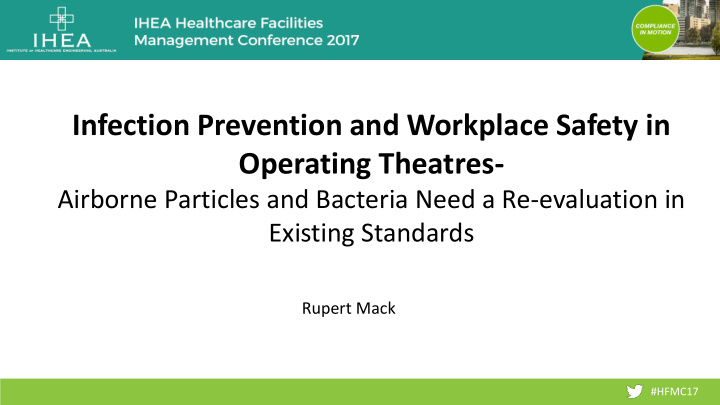



Infection Prevention and Workplace Safety in Operating Theatres- Airborne Particles and Bacteria Need a Re-evaluation in Existing Standards Rupert Mack #HFMC17
#HFMC17
Worldwide we differentiate two types of airflow Unidirectional Airflow Turbulent Mixing Ventilation ISO 14644-3 (Class 5) ISO 14644-3 (Class 7) #HFMC17
Turbulent Mixing Ventilation (ISO 14644-3 Class 7) (German DIN 1946-4 Class Ib, Dilution Mixing System) - No protected zone/area - 20-25 ACH or > 60 m3/m2xh - Recovery-Time < 25 min (Particles 100:1 recovery) #HFMC17
Turbulent Mixing Ventilation (ISO 14644-3 Class 7) (German DIN 1946-4 Class Ib, Dilution Mixing System) - No protected zone/area - 20-25 ACH or > 60 m3/m2xh - Recovery-Time < 25 min. (Particles 100:1 recovery) #HFMC17
Unidirectional Airflow (ISO 14644-3 class 5) (German DIN 1946-4 Class Ia, Laminar Flow, Low Turbulent Displacement Flow) - Protected Zone System - 300-400 ACH in protected zone - Recovery-Time < 0,5 min (Particles 100:1 recovery) #HFMC17
Unidirectional Airflow (ISO 14644-3 class 5) (German DIN 1946-4 Class Ia, Unidirectional Airflow, Laminar Flow, Low Turbulent Displacement Flow) - Protected Zone System - 300-400 ACH in protected zone - Recovery-Time < 0,5 min (Particles 100:1 recovery) Size of Protected Zone signed on the floor #HFMC17
Tasks of a Unidirectional Airflow Protection of wound area, instruments and sterile clothed personnel (Size of protected zone: acc. Positioning Analyses, min. 3 x 3 m) Video shows the Unidirectional Downflow: - the segregation of the protected zone from the periphery area by preventing entrainment of ambient room air. - Washing out within half a minute (downflow) #HFMC17
Diagram of a modern protected zone system (Unidirectional Airflow) Benefit: • Reduction of energy consumption by recirculation • Reduction of the duct profile coming from the air-conditioning unit • Air flow rate adjustment possible independently of air-conditioning unit and duct system • For retrofitting of existing installations #HFMC17
Issue Workplace Safety: Health risks for surgeons due to surgical smoke Surgical Smoke: - Arises from High Frequency (HF) Surgery - Emerging health risks of surgeons due to increasing numbers of HF-surgeries #HFMC17
Health risks for surgeons due to surgical smoke. Study Netherlands Study:Tjeerd de Boorder et. al. Netherlands The consistence of surgical smoke is more harmful than cigarette smoke !! #HFMC17
Health risks for surgeons due to surgical smoke. Study China Breathing in of surgical smoke half a minute is equivalent of smoking one cigarette !!! #HFMC17
Solution: Surgical Smoke Extraction implemented in an a Laminar Flow Canopy Benefit: • Laminar flow pushes the surgical smoke down to the origin (Turbulent Mixing Flow can not!) • Odors, aerosols nanoparticles and other hazardous particles are transported into the open (no recirculating) • Low noise emission as pump is outside the operating theatre #HFMC17
Solution: Surgical Smoke Extraction implemented in an a Laminar Flow Canopy Benefit: • Optimum protection of surgeons against particles, aerosols, nanoparticles and other hazardous substances • Clear view thanks to direct extraction and possibility to work independently without additional staff (nurse) #HFMC17
Issue Infection Prevention: Comparison in terms of Airborne Bacteria! Turbulent Mixing Ventilation Unidirectional Airflow #HFMC17
Study: Turbulent Mixing Ventilation compared with Unidirectional Displacement Flow #HFMC17
Study: “Reduction of Airborne Bacterial Burden in the OR by Installation of Unidirectional Airflow “ Turbulent Mixing Ventilation Unidirectional Airflow Result: “Protected Zone Systems“ (Unidirectional Airflow) reduces the bacterial burden by more than 90 %. #HFMC17
Lay-up preparation room/area (for instruments) „Rooms/areas where sterile packed instruments are opened, stored, checked and arranged on the trollies must have the same air cleanliness as they have during surgery“ #HFMC17
Innovation: Continuous Particle Monitoring Show the cleanliness Keep an eye on instruments Quality control and risk management #HFMC17
Diagram of a contiuous particle monitoring system (CPM) Benefit: • Prevention of infection through the continual monitoring of the air quality • Light -screen display to show the current air quality • Increasing awareness among the surgical staff and protection of the sterile chain • Clean air supply adapted to suit requirements • Quality management possible for every operation thanks to documentation #HFMC17
Video shows how Continuous Particle Monitoring works Video CPM #HFMC17
Glass Flow Stabilizer Innovation avoids the risk of collision Air Curtain System Complenate and Screenless The longer the glass pane the larger the protection zone The longer the glass pane the bigger the risk of collision (lights pendants) #HFMC17
Modern Design of an Operating Theater Continuous Air curtain Particle system Monitoring Unidirectional Airflow Canopy Protected Zone #HFMC17
Summery: - Unidirectional Airflow (Laminar Airflow) only assures a Protected Zone/Area - Protected Zone/Area has to cover wound (situs), personnel as well as instruments (min. 3m x 3m) - Protection Zone/Area only meets the requirements referring to nowadays issues Infection Prevention and Workplace Safety (Surgical Smoke) - Existing Standards are behind and have to be re-evaluated (… as long lasting we can not wait !!) #HFMC17
Thank you for your Attention Rupert Mack #HFMC17
Recommend
More recommend